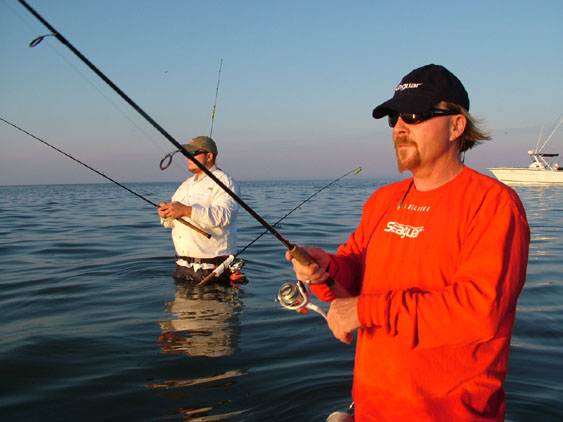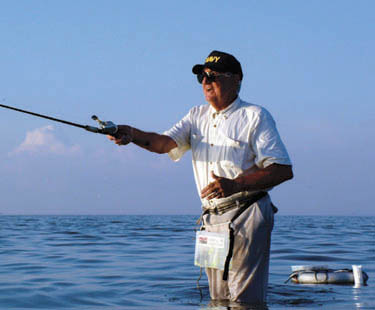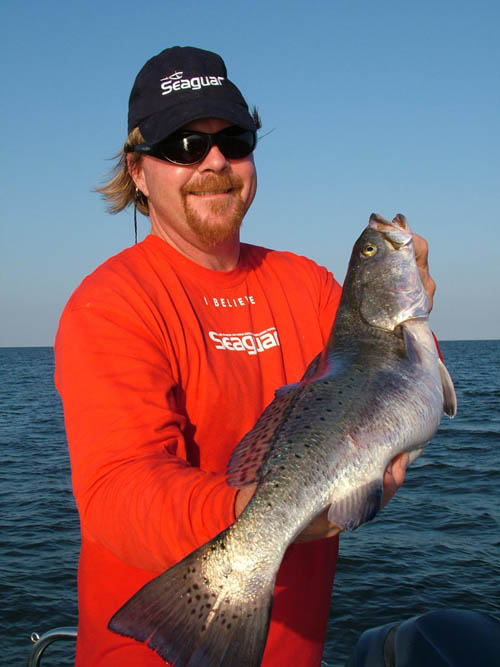
The Saltwater Magazine for Gulf Coast Fishing!
FISHING FORECASTS
| FISHING CALENDARS | ARTICLES | ADVERTISE
| SUBSCRIBE
Search Gulf Coast Fisherman's
Web Site
Past articles, specific
places or fish, etc.

Breton Island
Made to Wade
By Al Rogers
| CURRENT
MOON lunar phases |

Breton Island is Made to Wade... (Mike Ellis and Capt. Peace Marvel)
Speckled trout enthusiasts generally fall into two categories. There are those who search out schools where they have the best chances of catching greater numbers. The action can be fast and furious on soft plastics in various colors and live shrimp under popping corks. A goal for many in this group is limits, or the maximum allowable catch.
There is another kind of angler who avoids schools, sacrificing numbers and action in a relentless hunt for the fish of a lifetime - a trophy speckled trout. These fish are generally loners, spending their final years in isolation. At seven pounds or heavier, these trout are rare when compared to the vast numbers of schooling fish. We often hear of double-digit specks caught in estuaries across the Gulf States. But you'll rarely hear about the old timers who have never caught a five-pound trout after trying for nearly 50 years.
Trophy trout fishermen are somewhat of an exclusive group. They know spawning patterns. They closely watch moon phases, water temperatures, tides, and salinities. They move into prime areas with the stealth of a cat and typically use bigger baits. They are extremely patient, sometimes fishing all day for two or three strikes.
They know that out of more than 150 trout estuaries in the Gulf of Mexico, only a few select regions have historically produced trophy specks. Some of these areas include the Lower Laguna Madre and Baffin Bay in Texas, or lakes Calcasieu and Pontchartrain in Louisiana. One of these big trout areas is Breton Island, just off the coast of southeast Louisiana.
It is a tiny island less than 10 miles east of Venice, Louisiana. And for generations this island has provided vital habitat for breeding fish to continue the cycle of life for future generations, or classes. Unlike some of the other trophy estuaries, Breton Island has little pressure because conditions must be perfect. And the eight-mile stretch of open water keeps many of the bay boats closer to shore.
With a hint of breeze, a full moon overhead and good tides, Wednesday, May 2, 2007 was one of those days.
"If you're looking for big trout this is the day you want to be out there," said Capt. Devlin Roussel, of the Venice, La.-based Reel Peace Charters. "We couldn't have asked for more perfect conditions."
Captains Peace Marvel and Mike Ellis had joined Roussel for the trip. Rounding out the crew was Alex Roger, a retired barrier islands guide, and Randy Matthews. The day had been marked on their calendars for months. Under the stars and the big moon the group left Cypress Cove Marina in 29-foot Glacier Bay Canyon Runner. After crossing the Mississippi River and making the short run through a pass (Baptiste Collette), it was an quick run to the legendary island.
For the last 14 days straight, Roussel, Marvel and Ellis had been fishing nearly around the clock. They had been on hot streak of 100- to 150-pound yellowfin tuna in the days, while catching swordfish up to 200 pounds at night. So when the trio managed to finally get a day off they naturally went fishing. Since 1995 Reel Peace Charters has built their reputation on pelagic species, particularly tuna. But they'll occasionally book barrier island trips in the spring and summer for anglers hoping to bag a trophy trout.
Fishing the legendary barrier islands holds a special appeal to this group of veteran anglers. Rogers, 75, worked as a mate on one of the first for-hire boats to the Chandeleur Islands in the late 1940s and early 1950s. It had been nearly 15 years since his last trip to Breton Isle, the southernmost island in the Chandeleur chain.
Barrier islands are evolving entities. They shift, build and erode with every Gulf breeze, every current, and every tidal change. If you attune yourself to your surroundings you can feel the dynamic forces of nature at work. While wading you can feel the grains of sand shifting beneath your feet. Changes can be gradual, and they can happen overnight. Because of this it is important to be careful.
Roussel eased the catamaran onto a shoal some 300 yards off the island. The view was spectacular. Thousands, perhaps hundreds of thousands of brown pelicans, gulls and terns covered the island and filled the skies. There was no question that this landmass belonged to the birds. In fact, it is a national wildlife refuge created in 1904 by President Theodore Roosevelt. Breton NWR is the second oldest refuge in the country.
 Not long ago Breton Island was home for species
such as nutria, rabbit, raccoon and loggerhead sea turtles. Lush beds of
sea grass and mangroves fill the interiors. The coves and interior ponds
were teaming with baitfish and crab. Along the shores rafts of mullet moved
in tight packs.
Not long ago Breton Island was home for species
such as nutria, rabbit, raccoon and loggerhead sea turtles. Lush beds of
sea grass and mangroves fill the interiors. The coves and interior ponds
were teaming with baitfish and crab. Along the shores rafts of mullet moved
in tight packs.
Marvel was first out of the boat and began trudging toward the school of baitfish. Occasionally the waters would erupt as predators rushed though the schools. With his Revo baitcaster, Marvel launched a MirrOure He Dog to the perimeter of the mullet. As he "walked" his plug through the school the beads snapped sharply with every twitch.
Not long after his second cast he noticed a disturbance in the water. Marvel twitched his plug once again and let it rest. Then it suddenly disappeared into a massive swirl. His rod tip lurched forward as a fish stripped lined from his spool. There was little question in his mind what was on the end of the line.
"Breton Island trout," he shouted. "This is what we came here for."
The big fish came to the surface and thrashed its head wildly. This was obviously a nice fish. It surfaced once again and slapped the water with its black tail. Marvel struggled to keep slack out of the line but the fish apparently knew something about evading capture. It thrashed again and this time managed to throw the plug.
"That's okay," Marvel said. "There's more where that came from."
Marvel estimated that the trout could have gone eight pounds. Naturally his estimation was a subject for debate back on the boat. But one thing is certain. Speckled trout of this size are difficult to catch. From their days as post-larval finfish, speckled trout develop swimming skills and learn how to evade predators. With astronomical mortality rates, every day is about survival. Only the strongest, healthiest, smartest, and yes, the "luckiest" trout will ultimately reach the size of the fish that Marvel just lost.
Roussel and Ellis had walked to the northwest end of the island where a series of sand bars pushed out into the sound. From a distance we could see they were on fish, although not the monsters we had hoped for. They returned in an hour with a stringer of fish that included five trout, two 26-inch redfish and two beautiful flounder.
Breton Island is blessed with just about every feature that fish will
find attractive. Hard sand bottoms cover the seafloor on the outer edges
of the island. The south and west ends of the island ha ve a series of
limestone rock to slow the erosion that has taken a toll on all of the Gulf's
barrier islands. Other areas have marshes that offer juvenile baitfish and
crustaceans a sanctuary of their own.
ve a series of
limestone rock to slow the erosion that has taken a toll on all of the Gulf's
barrier islands. Other areas have marshes that offer juvenile baitfish and
crustaceans a sanctuary of their own.
"I think it's all about the location of the island," Roussel said. "It's in such a close proximity to passes of the Mississippi River Delta."
Between the marsh shores of the prolific Delta region and Breton Island are some oil and gas platforms. But Breton Island is essentially the first ideal spawning area that the fish find when they leave the interior estuaries in the early spring.
"This is perfect spawning habitat," he said. "There's really no reason for the fish to look any further."
It had been a fairly productive morning. But we still had not yet landed any trout big enough to earn the title of a trophy. Rogers had hooked but lost a good trout while Ellis and Matthews caught sever more in the three-pound class. By noon the water had become stained and Roussel suggested we move to find cleaner water.
"There's a tip of the island to the southwest that we should try," he said. "Around the perimeters of most of these areas there will be deeper troughs. The big trout will be in these deeper areas and working the shelves."
He anchored the Glacier Bay and we gathered all of the tools necessary for a successful wade. The floating fish baskets were equipped with rod holders and a small tackle box. Some had small landing nets or fish grabbers and pliers.
With cleaner water Marvel brought salt-pepper/chartreuse Saltwater Assassins and quarter-ounce jig heads. He walked through the trough, positioned himself near the bank and started casting. On his first cast the big speck engulfed the soft plastic.
"There he is," Marvel said. "It's a mule."
Determined not to lose this one, Marvel backed up to the bank. The fish ran deep stripping line off his Revo.
"Big trout big trout," he said.
Within a minute he guided the fat speck onto the bank. He held up the 28-inch trout and smiled.
"This is why you come to Breton Island," he said proudly. "This is what we want."
The speck weighed just less than five pounds. Not a trophy by most standards but Marvel could not have been any happier.
"Nice fish," Roussel said as he helped Marvel subdue the fish. "Now get back in the water and get another one."
That afternoon was good as we managed to catch another nine specks in the two- to three-pound class. Truth be told, none of us consider ourselves accomplished trophy trout anglers. But we do share a common philosophy in that we have never likened the quality of a trip to the numbers of fish caught.
And we will be back as long as there is a Breton Island to fish. Who knows, maybe next time one of us will catch a legitimate trophy. There's no question that fish is out there.

